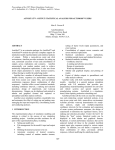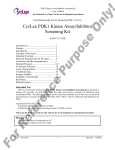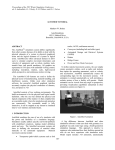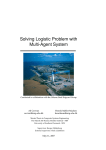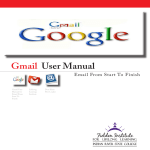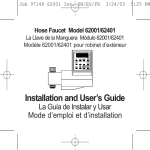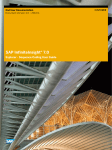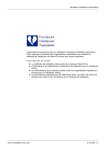Download AutoSched Tutorial - INFORMS Simulation Society
Transcript
Proceedings of the 1996 Winter Simulation Conference ed. J. M. Cbarnes, D. J. Morrice, D. T. Brunner, and J. J. Swain AUTOSCHED TUTORIAL Matthew W. Rohrer AutoSimulations 655 E. Medical Drive Bountiful, Utah 84010, U.S.A. ABSTRACT INTRODUCTION The AutoSched™ fmite capacity planning and scheduling tool helps you increase throughput, reduce in-process inventory, and increase equipment and personnel utilization. AutoSched efficiently schedules all of the constraints in your factory, such as shift schedules, work setup rules, batching, preventative maintenance, machine efficiency, and operator skill classes. The AutoSched manufacturing capacity planning and scheduling tool is a template built on the AutoMod simulation engine. For most manufacturing problems, the AutoSched spreadsheet interface can be used to build models without programming. Typical data includes part routings, machine mean time between failures, and setup requirements. In an AutoSched model, the equipment (station) is the intelligent decision maker, employing task selection rules to detennine the processing sequence. AutoSched provides extensive reports, including Gantt charts for all model entities. With AutoSched, you can identify your bottleneck resources and apply intelligent operating rules to improve perfonnance. One manufacturer reduced its average cycle time from 25 to 5 days, and reduced inprocess inventory to one-fifth previous levels using AutoSched. Scheduling with AutoSched allows you to set accurate commit dates, based on the current mix of work, available resources, and existing commit dates. Because AutoSched is built on the foundation provided by AutoMod, 3-D animation is generated automatically (see figure 1). Users can defme material movement systems and connect them to AutoSched models, adding the details of material movement between work operations. If the system being modeled has detailed rules of operation that are not part of standard AutoSched, the AutoMod language can be employed to represent complex algorithms. AutoSched uses the AutoMod™ simulation system, AutoSimulations, proprietary simulation technology. AutoMod provides the discrete event simulation engine, 3-D graphics, and material handling constructs that are the foundation for AutoSched. Built-in task selection rules in AutoSched allow you to model how machines and personnel select tasks to increase factory perfonnance. You can also easily customize AutoSched with an engineering-oriented, English-like language that provides the flexibility to create custom task selection rules. In addition to scheduling, the AutoSched planning tool can be used for capacity analysis. Simulation technology makes it possible for you to quickly and easily consider what if questions such as, What new equipment do we need to buy for producing the new product? Simply add the new equipment to the model, rerun it, and review the results. Effects of capital acquisitions, process changes, and changing product mixes can be evaluated prior to implementation. Figure 1. AutoSched Animation 506 AutoScbed Tutorial AUTOSCHEDINTERFACE An AutoSched model is created mostly by populating AutoSched spreadsheets, called edit tables. The file format in AutoSched is flexible, with column order defmed by the column headings. Definitions for all input fields are provided in the table-specific help, and data discrepancies tell the user when a data input error has been made. Manufacturing models can be built faster and with greater accuracy in AutoSched than with other simulation and scheduling products. The AutoMod foundation provides support for material movement systems as well as 3-D animation for better communication and visualization between engineers, production personnel, and managers. Figure 2 shows some of the AutoSched user interface. 507 If there is more than one part on the FWL, the station applies a task rule to make the "best" choice. Task selection rules include fITst in, first out (FIFO), same setup, shortest processing time, etc. There are 120 standard rules in AutoSched. Operators can also employ task selection rules to make decisions. Other factory resources, such as operators, are modeled with the same ease as stations. Each station can have one or more calendars associated with it. Calendars specify when stations are unavailable for work.Calendars may be attached to factory resources to defme preventive maintenance times, random downtimes, and shifts. Lots flow between station families in a AutoSched model. Lots consist of a quantity of pieces of a given type of part and flow according to a routing that you defme using manufacturing terminology. The parts moving through a system have routings associated with them that defme the processing sequence. Routings include the station, processing time, and setup requirements for each part at each processing step for the part. Yield and rework fields may also be included at any step. The demand on a manufacturing system is described in an order file. The part type, number of parts per lot, start time, and due date are defmed as an order. Figure 2. AutoSched User Interface AUTOSCHED WORLD VIEW AutoSched represents a manufacturing system as a number of stations. Stations can be machines, work benches, assembly positions, or any location where work is performed on a product. A station is made up of a machine with input and output queues, task rules, and downtime defmitions. A group of stations that performs essentially interchangeable work is called a family. Every station belongs to a family, even if the family contains only a single station. Families share a common input queue and work list for parts waiting for service from one of the stations in the family. When a station completes its current task, it scans the family work list (FWL) to fmd another part to work on. Task selection rules are the criteria the station uses to determine which lot to work on next. The task selection rule allows the station to either pick a lot from the potential parts or to wait for a better choice. The status of operators, tools, components, and other constraints may be considered in a task selection rule. DATA REQUIREMENTS To use AutoSched, you must provide three basic types of input: • Factory resources (stations, operators, tools, storages, rules, calendars) • Products (parts, BOM, routings, setup matrix, purchased parts, movement itineraries) • Demand (factory orders, maintenance, work orders) preventative AutoSched is extremely flexible in that it is only necessary to provide the data that is currently available. For example, if you do not want to include the detail of modeling human operators, you do not have to include it. S08 Ruhrer In addition, AutoSched has defaults for almost all of the possible features. The data required for AutoSched can be entered from existing data bases or spreadsheets, or it can be entered through the powerful AutoSched edit tables. An edit table allows the user to input or modify data in a standalone or integrated database fashion. PICTURE CONSTRUCTION IN 3-D Both dynamic and static objects can be displayed during model execution. Dynamic objects represent stations, operators, and lots. The static layout is th~ background graphics of the plant. It may contain column lines, aisle markings, and walls. Labels can identify specific areas in the facility There are several ways to create a layout of the system to be modeled. AutoSched comes with a three-dimensional graphics editor that allows the user to construct objects from standard graphics primitives. Cone, box, hemisphere, trapezoid, frustum, cylinder, arc, vector (list), set, text, and triad are primitives that can be selected, placed, and scaled to create any static entity in the facility. AutoSched also has the ability to import CAD information through the IGES standard. The acronym 4'IGES" stands for the Initial Graphics Exchange Standard. IGES is an industry standard exchange format for translating graphic data from one CAD system to another. Any IGES file of a plant layout that was created in a CAD system can be easily imported into AutoMod. TOOLS FOR EVALUATING RESULTS GRAPHS Graphs in AutoSched are easy to define and update with the animation. Graph types include bar charts, pie charts, and timelines. Figure 3 shows a typical timeline business graph. Any model entity can be attached to a graph, including transporter vehicle velocity, number of loads on a conveyor section, or average utilization of a machine. Graphs can be printed or plotted to a variety of supported output devices, and graph displays can be controlled using the AutoMod language. Figure 3. AutoSched Timeline Business Graph RUN CONTROL The AutoSched Run control allows users to define the warm-up and steady-state periods for the model by resetting time-persistent statistics. Reports can be printed for any run control period, or "snap." Business graph output can be automatically created, as well as post-processed animation records. These animation records can be played back after the simulation run with AutoView™. Run control also provides an entity tracing capability that gives the model builder an event-by-event account of the model run. Tracing infonnation is useful in verifying and validating a model. REPORTS AutoSched provides extensive reports on all defined entities. Station states are tracked, including percent of time: • Processing • Setting up Off shift • • Conducting preventive maintenance • Down • Idle • Waiting for an operator • Waiting for tool Reports are presented in edit table fonnat, and can be sorted on any column. They can also easily be exported to other spreadsheet and databases for evaluation. AUTOSCHED BENEFITS • Data Organization - You simply organize the data to defme the model; you do not program. AutoSched Tutorial • • • • • Real-world Decision Orientation - Stations, operators, and tools, rather than orders, make the decisions about what to work on next. This reflects how decisions are made in the real world, i.e., by operators who can look at the entire system. Calendar Capability - The simulation clock is converted to a calendar clock (month, day, year, hour, minute, and second). You can defme an unlimited number of calendars and attach them to equipment and personnel. Calendars include information such as scheduled maintenance and holidays. Schedule Diagnostics - AutoSched provides Gantt charts and business graphs to help you visually interpret the schedules (see figure 4). Because AutoSched is based on AutoMod, animation aids in the understanding of scheduling dynamics. Flexibility - With AutoMod and AutoSched, the same tool can be used for: • Factory simulation • Finite capacity planning and analysis Gantt Chart by Order States Legend Orderl2 OrderlO Order5 Order] Order2 Order15 OrderS OrderS Order13 Order9 Order! 1 Orderl Orderl" Order4 Order) o ;-i:i5i- o o • • o o o Off Shift PM Down Processing Setup Idle Waiting Operator W~tingTool Exception o 6 Day 10 11 12 Figure 4: Sample Gantt Chart SUMMARY AutoSched is a powerful capacity planning and scheduling tool that allows manufacturing and process engineers to operate their facilities with greater efficiency. Because it is simulation based, AutoSched supports very detailed models where factory performance and model performance are within a few percentage 509 points. This level of accuracy is required by many scheduling applications. AutoSched provides an easy to use spreadsheet interface and flexible input file format that facilitate rapid model development. The AutoMod language can be used to customize models to achieve a higher level of modeling accuracy. The AutoMod foundation also provides 3-D graphics and material handling system constructs. AutoSched has been used in many manufacturing operations to gain operating efficiency and to provide daily decision support. REFERENCES AutoSimulations, Inc. 1989, AutoMod User's Manual. AutoSimulations, Inc. 1989, AutoMod Lessons Guide. BIOGRAPHY MATT ROHRER, Vice President of Products, joined AutoSimulations, Inc. in 1988. Serving as a Simulation Analyst for five years, Mr. Rohrer completed simulation projects in distribution, manufacturing, and material handling. As a user and developer of AutoMod and AutoSched, he has contributed to the enhancement of AutoSimulations' products to make them the most powerful simulation and scheduling products available. His main interest is in extending the use of simulation technology beyond its traditional application in planning and design. Mr. Rohrer received a BS in Engineering from the University of Utah in 1983.





